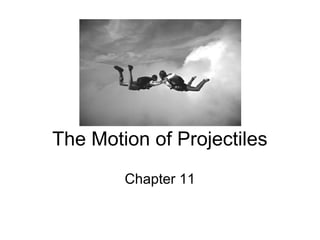Physics 504 Chapter 11 The Motion of Projectiles
•Als PPT, PDF herunterladen•
0 gefällt mir•2,669 views
The document discusses the motion of projectiles. It states that: 1) A projectile's velocity has two independent components: horizontal and vertical. The horizontal velocity does not change, while the vertical acceleration is constantly downwards at 9.81 m/s^2. 2) Examples show how to use kinematic equations to solve two-dimensional motion problems by separating the horizontal and vertical motions. 3) An example activity calculates that a ball thrown horizontally at 5 m/s from a roof 50 m high will hit the ground after 3.2 seconds and have traveled 16 meters horizontally.
Melden
Teilen
Melden
Teilen

Empfohlen
Empfohlen
Weitere ähnliche Inhalte
Ähnlich wie Physics 504 Chapter 11 The Motion of Projectiles
Ähnlich wie Physics 504 Chapter 11 The Motion of Projectiles (20)
projectile motion horizontal vertical -170213175803 (1).pdf

projectile motion horizontal vertical -170213175803 (1).pdf
projectile motion horizontal vertical -170213175803 (1).pdf

projectile motion horizontal vertical -170213175803 (1).pdf
Mehr von Neil MacIntosh
Mehr von Neil MacIntosh (20)
Physics 504 Chapter 11 The Motion of Projectiles
- 1. The Motion of Projectiles Chapter 11
- 2. Velocity Components • The velocity of a projectile is comprised of two independent components: horizontal and vertical. • Time of flight is determined by vertical motion only. • Vertical acceleration is downwards at 9.81 m/s2 • Horizontal velocity does not change • Horizontal acceleration = 0
- 3. Solving 2D Motion Questions • Vertical motion uses one of the 3 equations • v = u + at • s = ut + ½ at2 • v2 = u2 + 2as • Horizontally: Distance = velocity x time
- 4. Activity • From a roof of a building 50 m high, a ball is thrown horizontally with a v of 5 m/s. When does the ball hit the ground and at what distance? • Given: Vertically: s = 50 m, u = 0, a = 9.81 m/s2 • Given: Horizontally: v = 5 m/s • Calculate time: • Calculate distance:
- 5. Activity • Time: s = ut + ½ at2 • 50m = 0t + ½ 9.81t2 • t = 3.2 s • Distance: d = vt • = 5 m/s x 3.2 s • = 16 m
- 6. Activity • Page 248, Q. 1-4 • Page 251, Q. 1- 5
- 7. Velocity at an Angle •
- 8. Example • A soccer player kicks a ball at 20 m/s at 25° • Time to teach max height: • Initial vx = v cosθ = 20 cos 25° = 18.1m/s • Initial vy = v sinθ = 20 sin 25° = 8.45 m/s • v = uy + at; 0 = 8.45 -9.81t; t = 0.862 s • Time of flight: time up = time down • 2 x 0.862 s = 1.724 s
- 9. Continued • Horizontal distance: • d =vxt = 18.1m/s x 1.724s = 31.2 m • Velocity and angle at contact: • v = √ (vx2 + vy2); v = u + at = 0 + 9.81x 0.762 = 8.45 m/s y • = √ (18.12 + 8.452) • = 20 m/s • Angle of contact = tan -1(8.45/18.1)=0.467 • = 25° = 335°
- 10. Activity • Page 257, Q 1-4 • Page 261, Q.1-5
